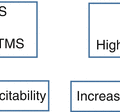Fig. 30.1
Microperimetry fixation evaluation in the left eye of a patient with late form of exudative age-related macular, before (left) and after (right) biofeedback training using MP1. After rehabilitation, the macular area used to fixate becomes smaller. Therefore, being fixation more stable, visual performances improve
Moreover, microperimetry is useful to assess the site and characteristic of PRL before and after rehabilitation. Greater fixation stability with better PRL at the end of vision rehabilitation explains the improvement of visual efficiency.
Previous studies demonstrated that the use of the MP-1 microperimeter acoustic biofeedback techniques in patients with macular diseases makes it possible to improve their visual performance, such as distant and near visual acuity, reading speed, reading comprehension, stabilizing fixation behavior or relocating the PRL, or both. Moreover, MP1-microperimeter offers a different biofeedback strategy, which uses a structured light stimulus (flickering pattern) plus acoustic biofeedback. Both methods seem to improve visual function. However, flickering pattern biofeedback training seems more useful in the rehabilitation of patients with low vision at the late stage of AMD, allowing to increase not only fixation stability and reading speed but retinal sensitivity and visual acuity, too [13].
Conclusion
New therapeutic strategies for exudative AMD have reduced the incidence of visual acuity reduction, preventing or slowing the development of a macular scotoma. However, due to the aging population, AMD is still one of the major causes of legal blindness among older people. Therefore, low vision treatment has an important role in the rehabilitation of the patients with central scotoma due to late AMD. The modern low-vision treatment, assessing components of residual visual function, such as retinal sensitivity, and functional vision, such as PRL and fixation stability, aims to adequately train residual area of the retina to fixate to improve visual performance.
Key Points
Age-related macular degeneration is one of the major causes of legal blindness among older people.
Loss of visual function reduces a person’s sense of independence and well-being.
Low-vision rehabilitation is a multidisciplinary professional service which provides methods and means for optimal use of residual visual function, training of residual vision-related skills, and reintegration in society.





